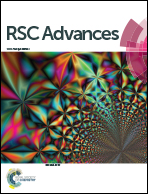Tumor cell responses to carbon dots derived from chondroitin sulfate
Abstract
Mass production of carbon dots (CDs) derived from chondroitin sulfate (CS) was developed by the facile hydrothermal approach for the first time. The CS derived CDs (CSCDs) possessed good dispersibility and water solubility, bright blue and green luminescence, and relative pH- and photo-stable properties. Moreover, the multicolor CSCDs could be efficiently uptaken by SAS cells and exhibited low cytotoxicity. Therefore, the responses of human oral squamous cell carcinoma SAS cells to CSCDs were further investigated by evaluating their proliferation and invasion. Compared to CS, CSCDs not only provided higher efficiency for proliferation of SAS cells, and up-regulated expression of matrix metalloproteinases to mimic extracellular matrix secretion, but also portrayed fluorescence for labeling SAS tumor cells. Hence, the multifunctional CSCDs are expected to have potential for biomedical applications.


 Please wait while we load your content...
Please wait while we load your content...